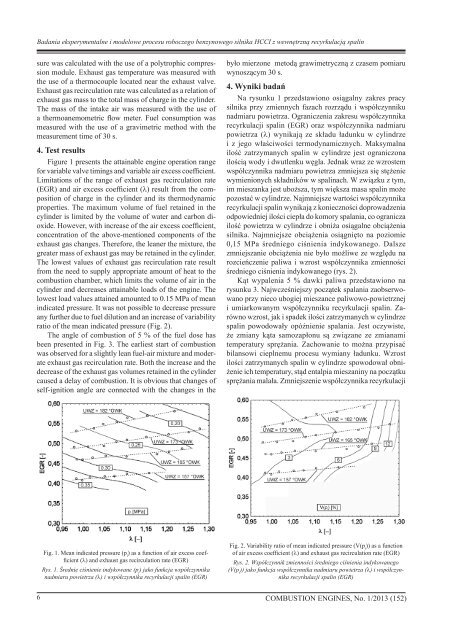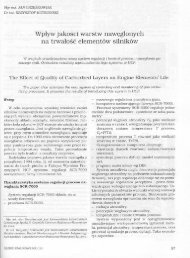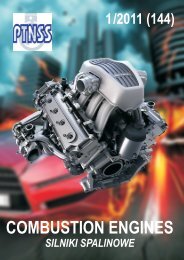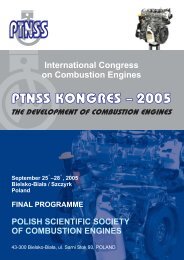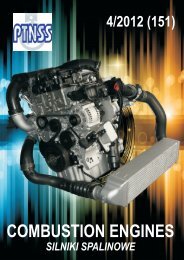Create successful ePaper yourself
Turn your PDF publications into a flip-book with our unique Google optimized e-Paper software.
Badania eksperymentalne i modelowe procesu roboczego benzynowego silnika HCCI z wewnętrzną recyrkulacją spalin<br />
sure was calculated with the use of a polytrophic compression<br />
module. Exhaust gas temperature was measured with<br />
the use of a thermocouple located near the exhaust valve.<br />
Exhaust gas recirculation rate was calculated as a relation of<br />
exhaust gas mass to the total mass of charge in the cylinder.<br />
The mass of the intake air was measured with the use of<br />
a thermoanemometric flow meter. Fuel consumption was<br />
measured with the use of a gravimetric method with the<br />
measurement time of 30 s.<br />
4. Test results<br />
Figure 1 presents the attainable engine operation range<br />
for variable valve timings and variable air excess coefficient.<br />
Limitations of the range of exhaust gas recirculation rate<br />
(EGR) and air excess coefficient (l) result from the composition<br />
of charge in the cylinder and its thermodynamic<br />
properties. The maximum volume of fuel retained in the<br />
cylinder is limited by the volume of water and carbon dioxide.<br />
However, with increase of the air excess coefficient,<br />
concentration of the above-mentioned components of the<br />
exhaust gas changes. Therefore, the leaner the mixture, the<br />
greater mass of exhaust gas may be retained in the cylinder.<br />
The lowest values of exhaust gas recirculation rate result<br />
from the need to supply appropriate amount of heat to the<br />
combustion chamber, which limits the volume of air in the<br />
cylinder and decreases attainable loads of the engine. The<br />
lowest load values attained amounted to 0.15 MPa of mean<br />
indicated pressure. It was not possible to decrease pressure<br />
any further due to fuel dilution and an increase of variability<br />
ratio of the mean indicated pressure (Fig. 2).<br />
The angle of combustion of 5 % of the fuel dose has<br />
been presented in Fig. 3. The earliest start of combustion<br />
was observed for a slightly lean fuel-air mixture and moderate<br />
exhaust gas recirculation rate. Both the increase and the<br />
decrease of the exhaust gas volumes retained in the cylinder<br />
caused a delay of combustion. It is obvious that changes of<br />
self-ignition angle are connected with the changes in the<br />
było mierzone metodą grawimetryczną z czasem pomiaru<br />
wynoszącym 30 s.<br />
4. Wyniki badań<br />
Na rysunku 1 przedstawiono osiągalny zakres pracy<br />
silnika przy zmiennych fazach rozrządu i współczynniku<br />
nadmiaru powietrza. Ograniczenia zakresu współczynnika<br />
recyrkulacji spalin (EGR) oraz współczynnika nadmiaru<br />
powietrza (l) wynikają ze składu ładunku w cylindrze<br />
i z jego właściwości termodynamicznych. Maksymalna<br />
ilość zatrzymanych spalin w cylindrze jest ograniczona<br />
ilością wody i dwutlenku węgla. Jednak wraz ze wzrostem<br />
współczynnika nadmiaru powietrza zmniejsza się stężenie<br />
wymienionych składników w spalinach. W związku z tym,<br />
im mieszanka jest uboższa, tym większa masa spalin może<br />
pozostać w cylindrze. Najmniejsze wartości współczynnika<br />
recyrkulacji spalin wynikają z konieczności doprowadzenia<br />
odpowiedniej ilości ciepła do komory spalania, co ogranicza<br />
ilość powietrza w cylindrze i obniża osiągalne obciążenia<br />
silnika. Najmniejsze obciążenia osiągnięto na poziomie<br />
0,15 MPa średniego ciśnienia indykowanego. Dalsze<br />
zmniejszanie obciążenia nie było możliwe ze względu na<br />
rozcieńczenie paliwa i wzrost współczynnika zmienności<br />
średniego ciśnienia indykowanego (rys. 2).<br />
Kąt wypalenia 5 % dawki paliwa przedstawiono na<br />
rysunku 3. Najwcześniejszy początek spalania zaobserwowano<br />
przy nieco ubogiej mieszance paliwowo-powietrznej<br />
i umiarkowanym współczynniku recyrkulacji spalin. Zarówno<br />
wzrost, jak i spadek ilości zatrzymanych w cylindrze<br />
spalin powodowały opóźnienie spalania. Jest oczywiste,<br />
że zmiany kąta samozapłonu są związane ze zmianami<br />
temperatury sprężania. Zachowanie to można przypisać<br />
bilansowi cieplnemu procesu wymiany ładunku. Wzrost<br />
ilości zatrzymanych spalin w cylindrze spowodował obniżenie<br />
ich temperatury, stąd entalpia mieszaniny na początku<br />
sprężania malała. Zmniejszenie współczynnika recyrkulacji<br />
Fig. 1. Mean indicated pressure (p i<br />
) as a function of air excess coefficient<br />
(l) and exhaust gas recirculation rate (EGR)<br />
Rys. 1. Średnie ciśnienie indykowane (p i<br />
) jako funkcja współczynnika<br />
nadmiaru powietrza (l) i współczynnika recyrkulacji spalin (EGR)<br />
Fig. 2. Variability ratio of mean indicated pressure (V(p i<br />
)) as a function<br />
of air excess coefficient (l) and exhaust gas recirculation rate (EGR)<br />
Rys. 2. Współczynnik zmienności średniego ciśnienia indykowanego<br />
(V(p i<br />
)) jako funkcja współczynnika nadmiaru powietrza (l) i współczynnika<br />
recyrkulacji spalin (EGR)<br />
6 <strong>COMBUSTION</strong> <strong>ENGINES</strong>, No. 1/2013 (152)


